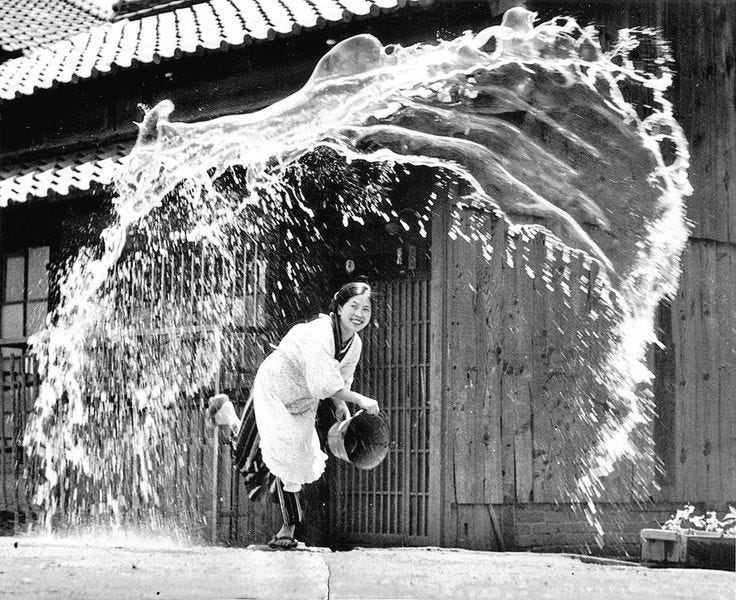vol 8. monthly recs & rabbit holes
soft-geometry, anatomy of a hug, the numinous
Sourced from full issue no. 48 of Rabbit Holes:
Here are the visuals, words, poetry, and art so far that stirred my soul for the month of April
1. 💻 Open this issue in your web browser (not phone) at a time where you have at least 30 mins to read.
2. ☕ Grab hot tea or coffee
3. 👚 Change into something comfortable and ideally sit against some fluffy pillows, with your computer on your lap at a 45 degree angle
4. Light a candle 🕯️
5. 💨 Take 5 breaths and listen to this meditation
6. Meditate on a question you have and run it by this iching reader
7. 🎵 Press play for music. Listen while you read this issue.
poetics & art.
[architecture] ancient town revived with concrete bookstore
Invited by the local government and Librairie Avant-Garde, TAO took on the task of repairing and renovating this historic academy in 2021, and has transformed it into a multipurpose bookstore that also serves as an exhibition space, small theater, and café.
[design studio] soft-geometry
Soft-geometry, established in 2019 by Indian designers (and married couple) Utharaa L Zacharias and Palaash Chaudhary, creates collectible furniture and objects that serve as poignant reflections on the universal yearning for softness in an often harsh world. With the narrative backdrop of Zacharias and Chaudhary’s own experiences of living and working between cultures in India and the US, soft-geometry’s objects explore the suspension between contemporary geometries and ritualistic hand-building inspired by Indian craft traditions.
words.
[podcast] Ezra Klein with Alison Gopnik
on the “numinous”:
So there’s this lovely concept that I like of the numinous. And sometimes it’s connected with spirituality, but I don’t think it has to be. It’s this idea that you’re going through the world. And often, quite suddenly, if you’re an adult, everything in the world seems to be significant and important and important and significant in a way that makes you insignificant by comparison. My colleague, Dacher Keltner, has studied awe. And awe is kind of an example of this. But the numinous sort of turns up the dial on awe.
And part of the numinous is it doesn’t just have to be about something that’s bigger than you, like a mountain. It could just be your garden or the street that you’re walking on. And suddenly that becomes illuminated. Everything around you becomes illuminated. And you yourself sort of disappear. And I think that’s kind of the best analogy I can think of for the state that the children are in.
[essay] Keeping Sacred Time
Our age is secular because time itself has been emptied of the sacred. We have given up our custodianship and joined the headlong sprint of secular time. And in so doing we have made ourselves unnecessary.
Rowan Williams says that “undifferentiated time” is one of the hallmarks of secular societies, and we are all dancing to its catchy, repetitive tune. Largely detached from the seasons, time feels like a headlong linear rush of news cycles punctuated by the commercial breaks of Black Friday and Starbucks Red Cup Day.
Williams believes that one of the hidden gifts of communal religious practice is the way it helps us locate ourselves in, and stay in fruitful relationship with, time.
He argues that liturgical traditions which observe the church calendar have a particular strength in this area. The steady rhythms of feasts and fasts, the narrative thread through the weeks and months, prevent time from being just about an accumulation of status and comfort. They instead make it an “accumulation of meaning.” By repeatedly returning to these stories, we discover new aspects of them, and of ourselves, bringing to them a slightly different person each year. We can connect whatever is going on in our own life at that moment with the “steady, regular, rhythmical patterns laid out in the language and practice of a religious community.” Time begins to feel neither straightforwardly cyclical (as in many early agrarian societies) nor shapeless and accelerating (as in ours); rather, it becomes a deepening spiral of meaning.
[letter] An astronaut's father sends love
On April 9th, 1959, Malcolm Scott Carpenter was announced by NASA as being one of seven astronauts chosen for Project Mercury, the United States’ program focused entirely on launching humans into space. Three years later, on 24th May, 1962, Carpenter boarded the Aurora 7 spacecraft and circled Earth three times, becoming the second American to orbit his home planet and the sixth human to fly in space. On the eve of his historic journey, Carpenter’s father, Marion, a chemist, proudly wrote him this letter.
You are probably aware that I am not a particularly religious person, at least in the sense of embracing any of the numerous formal doctrines. Yet I cannot conceive of a man endowed with intellect, perceiving the ordered universe about him, the glory of the mountain top, the plumage of a tropical bird, the intricate complexity of a protein molecule, the utter and unchanging perfection of a salt crystal, who can deny the existence of some higher power.
Whether he chooses to call it God or Mohammed or Buddha or Torquoise Woman or the Law of Probability matters little. I find myself in my writings frequently calling upon Mother Nature to explain things and citing Her as responsible for the order of the universe. She is a very satisfactory divinity for me. And so I shall call upon Her to watch over you and guard you and, if she so desires, share with you some of Her secrets which She is usually so ready to share with those who have high purpose.
[essay] Realization of Completeness
Satisfaction arises from the recognition of the moment being perfectly complete as it is. Whatever state that arises, being complete, even those including states of conditioned dissatisfaction, such as “I want this” or “I do not want this”, is satisfactory as sensation. States that range from “the best”, such as the most pleasurable formless meditations, to “the worst”, such as experiences of intense pain and hate are both experienced as complete, and therefore satisfactory as sensation. Most of our experience with our most unwanted states is free of any lack of presence: we do not want the states, and have gone beyond any capability to push away or ignore the sensation. Paradoxically, then, states with less extreme negative valence have more opportunity for loss of presence, as do states with extreme positive valence.
In some sense, there is only one thing to “do”, and that is release of the triple action of clinging attachment, pushing away, and active ignorance of sensation, if they are being done. There is simply not any perfect or universal way to point out how to release a very subtle action that may not be broaching the threshold of conscious recognition. In some sense, the release is no more complicated than asking someone to lie down on the floor and relax their muscles, and noticing what tensions remain even after the attempt; some tensions that are not in consciousness will have tensions that do not become conscious even when skillfully pointed out. Effortfully trying to relax often only adds other subtle tension in the attempt to remedy. Releasing the triple action, similarly, has no graduated path that can do anything more than cultivate the possibility of sudden recognition of the triple action, with subsequent immediate release. Once the capability of release is first known, it becomes more familiar, and confidence builds up in the capability for continuous release and dissolves habitual holding that would require release.
[profile] meet mary enoch elizabeth baxter
“It’s the refusal to be conquered. Like, get the fuck out of here. Evil is so boring. I think Toni Morrison speaks to that, like that shit is getting tired. Good is so vast and beautiful. The beauty for me is in transmuting the trauma — taking something that was meant to destroy me and making it into something that actually serves me and can propel me forward. It gives me a deeper perspective. If these things didn’t happen, I wouldn’t have been motivated to learn why. And art for me has been a place to learn why. And it gives us distance to process and allows us to inevitably heal.”
— on hope, beauty, and transmuting trauma
[essay] The Virtuous Cycle of Aliveness
There is a voice in me, in my gut, my core – the voice of my truest desires for this life. It speaks in moments small and large. A walk outside would feel good. I want to move to a new city.
When I live through this voice, aliveness opens. When I override it, aliveness closes.
The effects of living from my core are fractals, transformative at all scales. It’s led to new recipes – I want shrimp, rice noodles, avocado, olive oil, and salsa right now – and it’s also what possessed me to sit down and meditate and journal and scream until I opened the memories of abuse I had repressed my whole life. Aliveness at every scale.
As aliveness opens, it creates more room for the voice of core, of intuition, to speak. As it closes, so too does the space for the voice of intuition.
This interdependence between aliveness and living from intuition creates a virtuous cycle: hear intuition, live from it, open aliveness, hear deeper intuition, live from it, open deeper aliveness, and so on.
There is a parallel vicious cycle: hear intuition, override it, close aliveness, lose some touch with intuition, live less from intuition, close more aliveness, and so on.


























